人教版(2019)选择性必修第二册Unit 5 First Aid Reading and Thinking 课件(共31张PPT,内镶嵌视频)
文档属性
| 名称 | 人教版(2019)选择性必修第二册Unit 5 First Aid Reading and Thinking 课件(共31张PPT,内镶嵌视频) |  | |
| 格式 | pptx | ||
| 文件大小 | 20.9MB | ||
| 资源类型 | 教案 | ||
| 版本资源 | 人教版(2019) | ||
| 科目 | 英语 | ||
| 更新时间 | 2024-03-22 20:15:36 | ||
图片预览

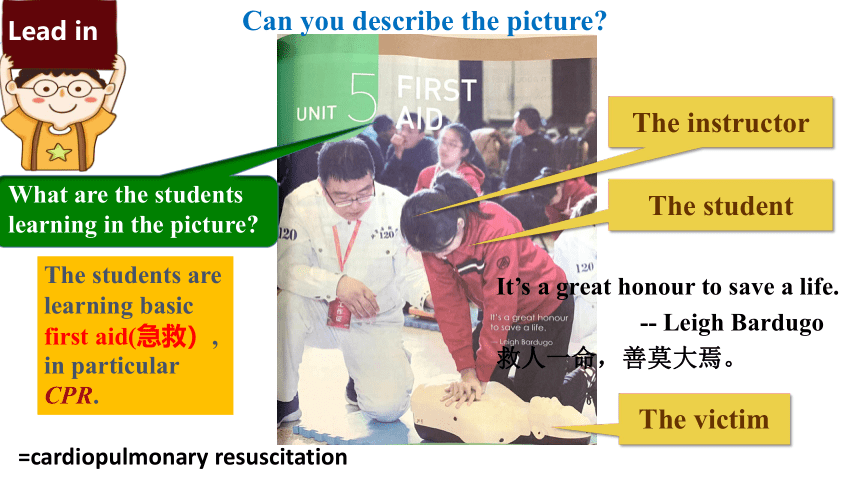
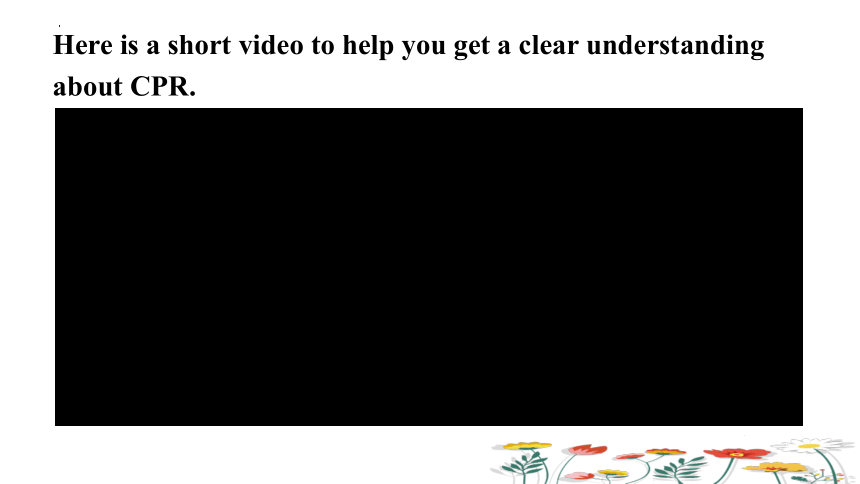
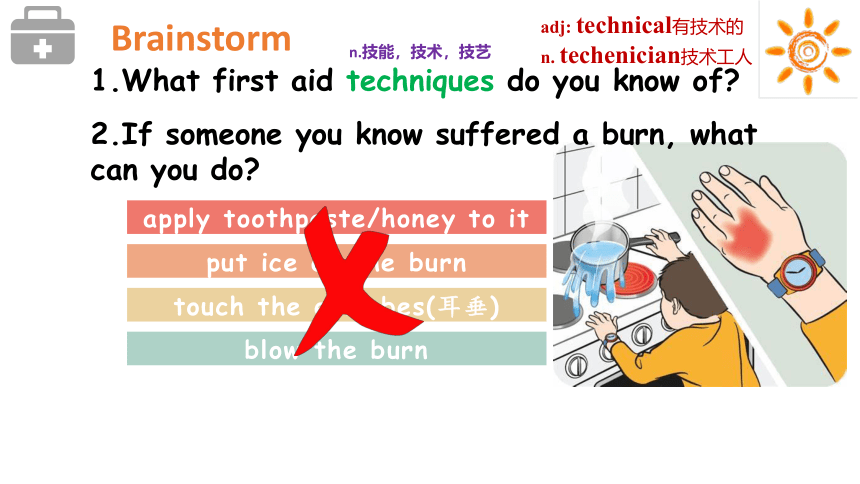
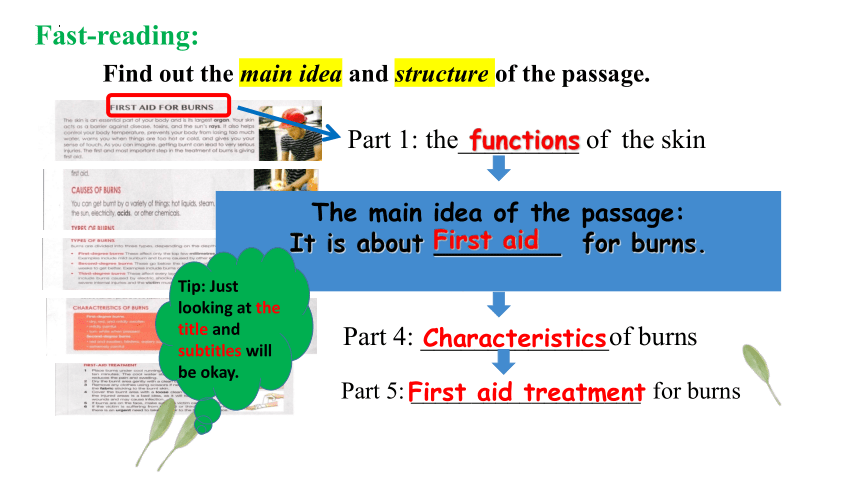
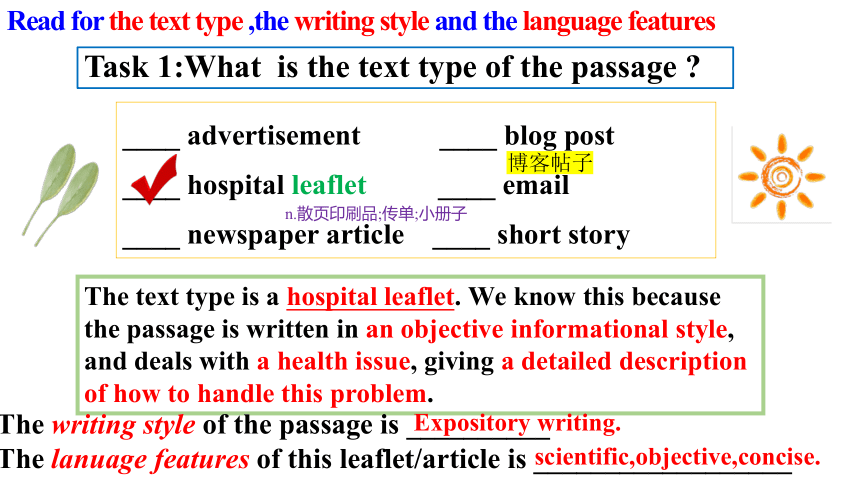

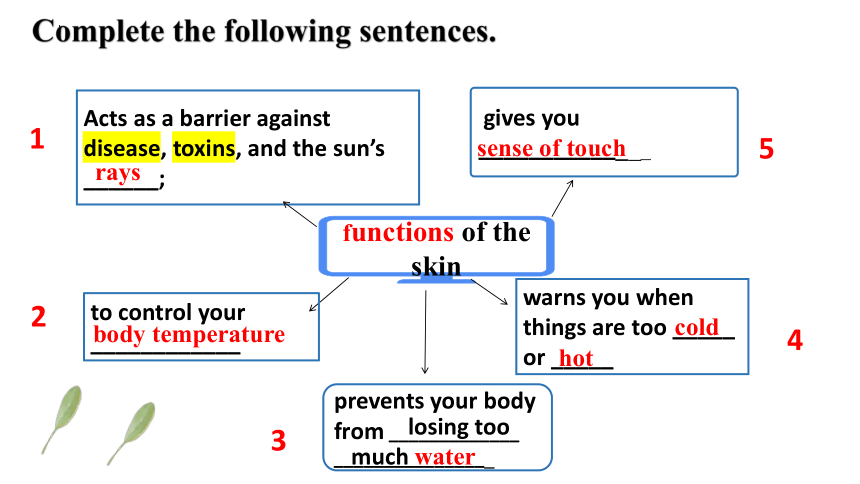
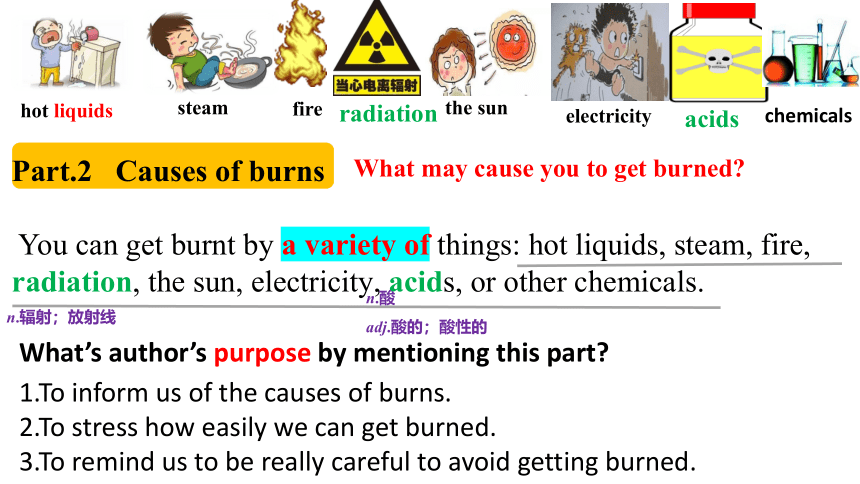
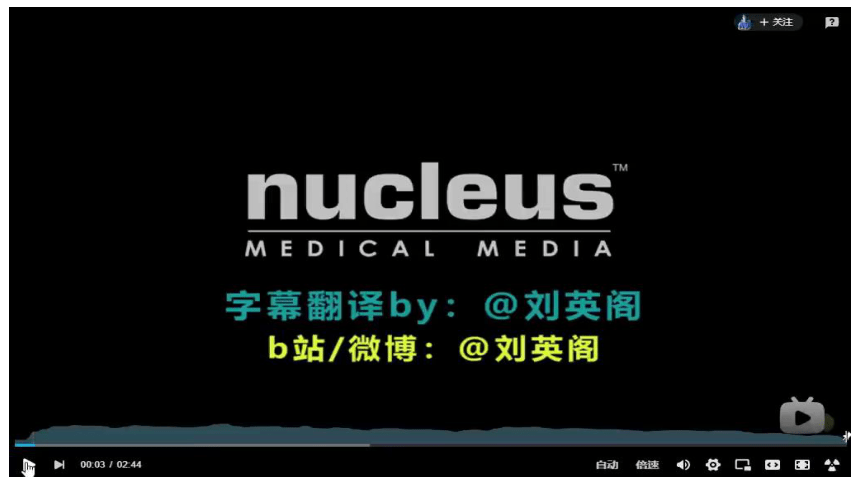
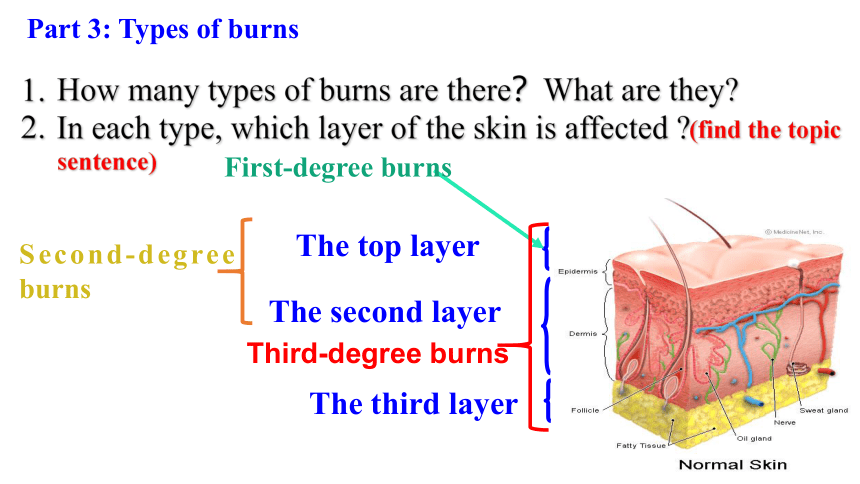
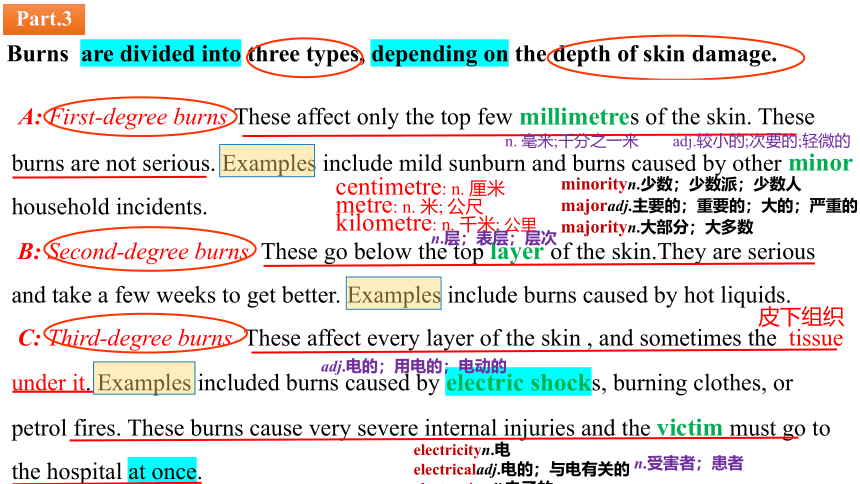
文档简介
(共31张PPT)
First Aid for Burns
While there is life,there is hope.
留得青山在,不怕没柴烧。
Lead in
Can you describe the picture
The instructor
The victim
What are the students learning in the picture
The students are learning basic first aid(急救), in particular CPR.
The student
=cardiopulmonary resuscitation
It’s a great honour to save a life.
-- Leigh Bardugo
救人一命,善莫大焉。
Here is a short video to help you get a clear understanding about CPR.
apply toothpaste/honey to it
1.What first aid techniques do you know of
2.If someone you know suffered a burn, what can you do
Brainstorm
put ice on the burn
touch the earlobes(耳垂)
blow the burn
n.技能,技术,技艺
adj: technical有技术的
n. techenician技术工人
Find out the main idea and structure of the passage.
Part 1: the_________ of the skin
Part 2: _________of burns
Part 3: _________of burns
Part 4: ______________of burns
Part 5: ___________________ for burns
Causes
Types
First aid treatment
Characteristics
The main idea of the passage:
It is about ________ for burns.
First aid
Fast-reading:
Tip: Just looking at the title and subtitles will be okay.
functions
____ advertisement ____ blog post
____ hospital leaflet ____ email
____ newspaper article ____ short story
Task 1:What is the text type of the passage
Read for the text type ,the writing style and the language features
博客帖子
The text type is a hospital leaflet. We know this because the passage is written in an objective informational style, and deals with a health issue, giving a detailed description of how to handle this problem.
The writing style of the passage is __________
The lanuage features of this leaflet/article is __________________
scientific,objective,concise.
Expository writing.
n.散页印刷品;传单;小册子
The skin is an essential part of your boby and is its largest
organ. Your skin acts as a barrier against disease,toxin,
and the sun's rays. It also helps control your body temperature,
prevents your body from losing too much water,
warns you when things are too hot or cold, and gives you
your sense of touch. As you can imagine, getting burnt
can lead to very serious injuries. The first and most important
step in the treatment of burns is giving first aid.
function
topic sentence
Part.1
Careful-reading:
The functions of the skin
How does the author describe the function of our skin
What’s the function of ‘as you can imagine’ and the last sentence
Transitional words. Lead to the following context.
By employing five verbs.
n.(人或动植物的)器官
n.光线;光束;(热、电等)射线
act as 充当;担当=serve as = work as
n.毒素
prevent... (from) doing .. .
阻止...做某事
=stop ...(from) doing ...
=keep...from doing....
=discourage...from doing...
Complete the following sentences.
functions of the skin
Acts as a barrier against disease, toxins, and the sun’s ______;
prevents your body from _____________
________________
warns you when things are too _____ or _____
gives you ______________
body temperature
losing too much water
cold
hot
sense of touch
to control your ____________
rays
1
2
3
4
5
Part.2 Causes of burns
You can get burnt by a variety of things: hot liquids, steam, fire, radiation, the sun, electricity, acids, or other chemicals.
What may cause you to get burned
hot liquids
steam
fire
the sun
electricity
acids
radiation
chemicals
What’s author’s purpose by mentioning this part
1.To inform us of the causes of burns.
2.To stress how easily we can get burned.
3.To remind us to be really careful to avoid getting burned.
n.辐射;放射线
n.酸
adj.酸的;酸性的
The third layer
The second layer
The top layer
First-degree burns
Second-degree burns
Third-degree burns
How many types of burns are there?What are they
In each type, which layer of the skin is affected (find the topic sentence)
Part 3: Types of burns
Burns are divided into three types, depending on the depth of skin damage.
A: First-degree burns These affect only the top few millimetres of the skin. These burns are not serious. Examples include mild sunburn and burns caused by other minor household incidents.
B: Second-degree burns These go below the top layer of the skin.They are serious and take a few weeks to get better. Examples include burns caused by hot liquids.
C: Third-degree burns These affect every layer of the skin , and sometimes the tissue under it. Examples included burns caused by electric shocks, burning clothes, or petrol fires. These burns cause very severe internal injuries and the victim must go to the hospital at once.
Part.3
皮下组织
n. 毫米;千分之一米
centimetre: n. 厘米
metre: n. 米; 公尺
kilometre: n. 千米; 公里
adj.较小的;次要的;轻微的
n.层;表层;层次
n.受害者;患者
adj.电的;用电的;电动的
electricityn.电
electricaladj.电的;与电有关的
electronicadj.电子的
minorityn.少数;少数派;少数人
majoradj.主要的;重要的;大的;严重的
majorityn.大部分;大多数
First -- degree burns:
● dry, red and mildly swollen
● mildly painful
● turn white when pressed
Second-- degree burns:
●red and swollen; blisters; watery surface
●extremely painful
Third--degree burns:
●black and white
●swollen; the tissue underneath can often be seen
●little or no pain if nerves are damaged; may be
painful around the edge of the burn
Part 4 : Characteristics of burns
Circle the key words.
adj.(身体部位)肿起的;肿胀的
swell vi.(swelled,swollen)膨胀;肿胀
red and swollen;
_______ __________
________
painful
second degree burns
first degree burns
dry, red and mildly ___________
_______ painful
third degree burns
black, white, swollen _________can be seen
___________
pain if nerves are damaged
Types
Characteristics
Feelings
blisters
watery surface
extremely
mildly
swollen
tissue
little or no
Part.4
1. Place burns under cool running water, especially within the first ten minutes.
The cool water stops the burning process and reduces the pain and swelling.
2. Dry the burnt area gently with a clean cloth.
3. Remove any clothes using scissors if necessary, unless you see the fabric sticking to burnt skin.
4. Cover the burnt area with a loose clean cloth. Applying oil to the injured areas is a bad idea, as it will keep the heat in the wounds and may cause infection.
5. If burns are on the face, make sure the victim can still breathe.
6. Get the victim to the doctor or hospital, if burns are second or third degree.
Don'ts
The dos and don’ts when someone gets burned.
According to the subtitle, what will the author mainly tell us in this part
Part 5: First aid treatment
stick to...粘到……上;坚持
stick to doing sth 坚持做某事
Part 5: First-Aid Treatment
dos
1. _______ burns under cool running water for 10 minutes
2. ______ the burned area gently.
3. ______ any clothes using scissors if necessary.
4. ______ the burned area with a loose, clean cloth.
5. ______ the victim to the hospital if serious.
don’ts
1. Don’t remove any clothes if they stick to the burnt skin.
2. Don’t apply oil to the burnt area.
3.If the burns are on the face, make sure the victim can breathe.
Place
Dry
Remove
Cover
Take
Imperative sentences
Give some
advice or
warnings
1.Put these steps in correct order.
___ Remove any clothes using scissors if necessary.
___ Place burns under cool running water.
___ Take the victim to the hospital if serious.
___ Dry the burnt area gently.
___ Cover the burnt area with a loose, clean cloth.
___ Make sure the victim can still breathe if burns are on the face.
1
2
3
4
5
Part 5
6
Details Types of burns
First-degree burns Second-degree burns Third-degree burns
Depth _______________________ of the skin __________________of the skin __________ of the skin and sometimes ____________ underneath
Examples
Description
top few millimetres
below the top layer
every layer
the tissue
Which one do you think is the most painful
mild sunburn
burns caused by other minor household incidents
burns caused
by hot liquids
burns caused by electric
shocks, burning clothes,
or petrol fires.
mild,minor,
not serious
serious
very serious
(The victim must go to
the hospital at once.)
Decide if the following statements are true (T) or false (F).
1. Your skin gives you protection from many dangerous things.
2. A first-degree burn has this name because it is the most serious.
3. Second-degree burns can be the most painful kind of burn.
4. It is important to use cool water to stop the heat from remaining in the wound regardless of the degree of the burn.
5. Putting butter or oil on burns helps because it may reduce swelling and ease discomfort.
T
F
T
F
T
F
T
F
T
F
Post reading: First-Aid Treatment
P51
top few millimetres
below the top layer
every layer
the tissue
swollen
painful
white
blisters
watery
painful
the tissue underneath
nerves
cooling water
dry
remove any
cover
still breathe
the hospital at once
Accidents can happen to anyone at any time.
But you can be the difference between life and death. So try to learn more about first aid in daily life.
Role play
Roles
Victim : get burnt
Character 1: describe the characteristics of the burns, judge the types of burns,
and give advice on the treatment
Character 2: carry out proper treatment on the victim with necessary explanation.
Summary
The skin is an e________part of our body. It acts as a b______ against disease, poisons and harmful rays. The functions of skin are very c_______. If our skin gets burned, first aid is a very important first step in the t________ of burns. We can get burned by a v______ of things. There are t_____ types of burns, d_______ on which layers of skin are burned. The first degree burns only affect the t_____ layer and are mildly s_______ and mildly p_______. The second degree burns are e _______ painful and take a few week to h____. The third degree burns may even affect t______ and organs under the skin and cause very s _____ injuries.
Therefore, it is v____ to give first aid treatment for burns correctly. For first and second degree burns, place burns under r______ water and place cool c______ on them. Never put butter, oil or o______ on the burns. For third degree burns, get the v______ to hospital at once.
essential
barrier
complex
treatment
top
swollen
painful
vital
running
cloths
variety
three
depending
extremely
heal
tissue
severe
ointment
victim
1. n.(人或动植物的)器官
2. n.光线;光束;(热、电等)射线
3. n.辐射;放射线
4. n.酸
adj.酸的;酸性的
5. n.层;表层;层次
6. n.受害者;患者
7. prep.& adv.在……底下;隐藏在下面
8. vt.& vi.吞下;咽下
重点单词
基 础 自 测
自主学习 落实基础知识
organ
ray
radiation
acid
layer
victim
underneath
swallow
9. vt.包、裹;(用手臂等)围住
10. n.毫米;千分之一米
→ n.米
11. adj.较小的;次要的;轻微的
→ n.少数;少数派;少数人
→(反义词) adj.主要的;重要的;大的;严重的
→ n.大部分;大多数
12. adj.电的;用电的;电动的
→ n.电
→ adj.电的;与电有关的
→ adj.电子的
wrap
millimetre
metre
minor
minority
major
majority
electricity
electric
electrical
electronic
13. vi.(swelled,swollen)膨胀;肿胀
→ adj.(身体部位)肿起的;肿胀的
14. n.神经
→ adj.紧张的
15. adj.松的;未系紧的;宽松的
→ v.(使) 放松,变松;解开
16. adj.紧急的;急迫的;急切的
→ v.敦促;催促;力劝
→ n.紧迫;急迫
swell
swollen
nerve
nervous
loose
loosen
urgent
urge
urgency
17. vi.& vt.(使)宽慰;减轻;缓解
n.容易;舒适;自在
→ adj.容易的;简单的
→ adv.容易地
ease
easy
easily
掌握规律 巧记单词
adj.+-en后缀变动词:
①结尾为e,只加n的情况:
wide→widen loose→loosen使放松
②直接加-en的情况:
tight→tighten使变紧 weak→weaken 削弱,(使)变弱
deep→deepen使……变深 fast→fasten使固定;系牢,扎牢
fall ill
get injured
act as
prevent… (from) doing
sense of touch
as you can imagine
a variety of
be/get close to
depending on
within a day or two
for a moment
electric shocks
at once
生病
受伤
充当
防止/阻止….做…
触感
正如你能想象的
各种各样的
靠近
取决于
一两天内
一会儿,片刻
触电
立刻
if necessary
be stuck to
squeeze out
over and over again
get infected
in place
if possible
sit up
it is vital to do….
knock over
catch fire
pick off
如果有必要
粘住
挤出
反复
被感染
在适当的位置
如果可能的话
坐直
做….至关重要
打翻
着火
摘掉;拔去
Thank you!
First Aid for Burns
While there is life,there is hope.
留得青山在,不怕没柴烧。
Lead in
Can you describe the picture
The instructor
The victim
What are the students learning in the picture
The students are learning basic first aid(急救), in particular CPR.
The student
=cardiopulmonary resuscitation
It’s a great honour to save a life.
-- Leigh Bardugo
救人一命,善莫大焉。
Here is a short video to help you get a clear understanding about CPR.
apply toothpaste/honey to it
1.What first aid techniques do you know of
2.If someone you know suffered a burn, what can you do
Brainstorm
put ice on the burn
touch the earlobes(耳垂)
blow the burn
n.技能,技术,技艺
adj: technical有技术的
n. techenician技术工人
Find out the main idea and structure of the passage.
Part 1: the_________ of the skin
Part 2: _________of burns
Part 3: _________of burns
Part 4: ______________of burns
Part 5: ___________________ for burns
Causes
Types
First aid treatment
Characteristics
The main idea of the passage:
It is about ________ for burns.
First aid
Fast-reading:
Tip: Just looking at the title and subtitles will be okay.
functions
____ advertisement ____ blog post
____ hospital leaflet ____ email
____ newspaper article ____ short story
Task 1:What is the text type of the passage
Read for the text type ,the writing style and the language features
博客帖子
The text type is a hospital leaflet. We know this because the passage is written in an objective informational style, and deals with a health issue, giving a detailed description of how to handle this problem.
The writing style of the passage is __________
The lanuage features of this leaflet/article is __________________
scientific,objective,concise.
Expository writing.
n.散页印刷品;传单;小册子
The skin is an essential part of your boby and is its largest
organ. Your skin acts as a barrier against disease,toxin,
and the sun's rays. It also helps control your body temperature,
prevents your body from losing too much water,
warns you when things are too hot or cold, and gives you
your sense of touch. As you can imagine, getting burnt
can lead to very serious injuries. The first and most important
step in the treatment of burns is giving first aid.
function
topic sentence
Part.1
Careful-reading:
The functions of the skin
How does the author describe the function of our skin
What’s the function of ‘as you can imagine’ and the last sentence
Transitional words. Lead to the following context.
By employing five verbs.
n.(人或动植物的)器官
n.光线;光束;(热、电等)射线
act as 充当;担当=serve as = work as
n.毒素
prevent... (from) doing .. .
阻止...做某事
=stop ...(from) doing ...
=keep...from doing....
=discourage...from doing...
Complete the following sentences.
functions of the skin
Acts as a barrier against disease, toxins, and the sun’s ______;
prevents your body from _____________
________________
warns you when things are too _____ or _____
gives you ______________
body temperature
losing too much water
cold
hot
sense of touch
to control your ____________
rays
1
2
3
4
5
Part.2 Causes of burns
You can get burnt by a variety of things: hot liquids, steam, fire, radiation, the sun, electricity, acids, or other chemicals.
What may cause you to get burned
hot liquids
steam
fire
the sun
electricity
acids
radiation
chemicals
What’s author’s purpose by mentioning this part
1.To inform us of the causes of burns.
2.To stress how easily we can get burned.
3.To remind us to be really careful to avoid getting burned.
n.辐射;放射线
n.酸
adj.酸的;酸性的
The third layer
The second layer
The top layer
First-degree burns
Second-degree burns
Third-degree burns
How many types of burns are there?What are they
In each type, which layer of the skin is affected (find the topic sentence)
Part 3: Types of burns
Burns are divided into three types, depending on the depth of skin damage.
A: First-degree burns These affect only the top few millimetres of the skin. These burns are not serious. Examples include mild sunburn and burns caused by other minor household incidents.
B: Second-degree burns These go below the top layer of the skin.They are serious and take a few weeks to get better. Examples include burns caused by hot liquids.
C: Third-degree burns These affect every layer of the skin , and sometimes the tissue under it. Examples included burns caused by electric shocks, burning clothes, or petrol fires. These burns cause very severe internal injuries and the victim must go to the hospital at once.
Part.3
皮下组织
n. 毫米;千分之一米
centimetre: n. 厘米
metre: n. 米; 公尺
kilometre: n. 千米; 公里
adj.较小的;次要的;轻微的
n.层;表层;层次
n.受害者;患者
adj.电的;用电的;电动的
electricityn.电
electricaladj.电的;与电有关的
electronicadj.电子的
minorityn.少数;少数派;少数人
majoradj.主要的;重要的;大的;严重的
majorityn.大部分;大多数
First -- degree burns:
● dry, red and mildly swollen
● mildly painful
● turn white when pressed
Second-- degree burns:
●red and swollen; blisters; watery surface
●extremely painful
Third--degree burns:
●black and white
●swollen; the tissue underneath can often be seen
●little or no pain if nerves are damaged; may be
painful around the edge of the burn
Part 4 : Characteristics of burns
Circle the key words.
adj.(身体部位)肿起的;肿胀的
swell vi.(swelled,swollen)膨胀;肿胀
red and swollen;
_______ __________
________
painful
second degree burns
first degree burns
dry, red and mildly ___________
_______ painful
third degree burns
black, white, swollen _________can be seen
___________
pain if nerves are damaged
Types
Characteristics
Feelings
blisters
watery surface
extremely
mildly
swollen
tissue
little or no
Part.4
1. Place burns under cool running water, especially within the first ten minutes.
The cool water stops the burning process and reduces the pain and swelling.
2. Dry the burnt area gently with a clean cloth.
3. Remove any clothes using scissors if necessary, unless you see the fabric sticking to burnt skin.
4. Cover the burnt area with a loose clean cloth. Applying oil to the injured areas is a bad idea, as it will keep the heat in the wounds and may cause infection.
5. If burns are on the face, make sure the victim can still breathe.
6. Get the victim to the doctor or hospital, if burns are second or third degree.
Don'ts
The dos and don’ts when someone gets burned.
According to the subtitle, what will the author mainly tell us in this part
Part 5: First aid treatment
stick to...粘到……上;坚持
stick to doing sth 坚持做某事
Part 5: First-Aid Treatment
dos
1. _______ burns under cool running water for 10 minutes
2. ______ the burned area gently.
3. ______ any clothes using scissors if necessary.
4. ______ the burned area with a loose, clean cloth.
5. ______ the victim to the hospital if serious.
don’ts
1. Don’t remove any clothes if they stick to the burnt skin.
2. Don’t apply oil to the burnt area.
3.If the burns are on the face, make sure the victim can breathe.
Place
Dry
Remove
Cover
Take
Imperative sentences
Give some
advice or
warnings
1.Put these steps in correct order.
___ Remove any clothes using scissors if necessary.
___ Place burns under cool running water.
___ Take the victim to the hospital if serious.
___ Dry the burnt area gently.
___ Cover the burnt area with a loose, clean cloth.
___ Make sure the victim can still breathe if burns are on the face.
1
2
3
4
5
Part 5
6
Details Types of burns
First-degree burns Second-degree burns Third-degree burns
Depth _______________________ of the skin __________________of the skin __________ of the skin and sometimes ____________ underneath
Examples
Description
top few millimetres
below the top layer
every layer
the tissue
Which one do you think is the most painful
mild sunburn
burns caused by other minor household incidents
burns caused
by hot liquids
burns caused by electric
shocks, burning clothes,
or petrol fires.
mild,minor,
not serious
serious
very serious
(The victim must go to
the hospital at once.)
Decide if the following statements are true (T) or false (F).
1. Your skin gives you protection from many dangerous things.
2. A first-degree burn has this name because it is the most serious.
3. Second-degree burns can be the most painful kind of burn.
4. It is important to use cool water to stop the heat from remaining in the wound regardless of the degree of the burn.
5. Putting butter or oil on burns helps because it may reduce swelling and ease discomfort.
T
F
T
F
T
F
T
F
T
F
Post reading: First-Aid Treatment
P51
top few millimetres
below the top layer
every layer
the tissue
swollen
painful
white
blisters
watery
painful
the tissue underneath
nerves
cooling water
dry
remove any
cover
still breathe
the hospital at once
Accidents can happen to anyone at any time.
But you can be the difference between life and death. So try to learn more about first aid in daily life.
Role play
Roles
Victim : get burnt
Character 1: describe the characteristics of the burns, judge the types of burns,
and give advice on the treatment
Character 2: carry out proper treatment on the victim with necessary explanation.
Summary
The skin is an e________part of our body. It acts as a b______ against disease, poisons and harmful rays. The functions of skin are very c_______. If our skin gets burned, first aid is a very important first step in the t________ of burns. We can get burned by a v______ of things. There are t_____ types of burns, d_______ on which layers of skin are burned. The first degree burns only affect the t_____ layer and are mildly s_______ and mildly p_______. The second degree burns are e _______ painful and take a few week to h____. The third degree burns may even affect t______ and organs under the skin and cause very s _____ injuries.
Therefore, it is v____ to give first aid treatment for burns correctly. For first and second degree burns, place burns under r______ water and place cool c______ on them. Never put butter, oil or o______ on the burns. For third degree burns, get the v______ to hospital at once.
essential
barrier
complex
treatment
top
swollen
painful
vital
running
cloths
variety
three
depending
extremely
heal
tissue
severe
ointment
victim
1. n.(人或动植物的)器官
2. n.光线;光束;(热、电等)射线
3. n.辐射;放射线
4. n.酸
adj.酸的;酸性的
5. n.层;表层;层次
6. n.受害者;患者
7. prep.& adv.在……底下;隐藏在下面
8. vt.& vi.吞下;咽下
重点单词
基 础 自 测
自主学习 落实基础知识
organ
ray
radiation
acid
layer
victim
underneath
swallow
9. vt.包、裹;(用手臂等)围住
10. n.毫米;千分之一米
→ n.米
11. adj.较小的;次要的;轻微的
→ n.少数;少数派;少数人
→(反义词) adj.主要的;重要的;大的;严重的
→ n.大部分;大多数
12. adj.电的;用电的;电动的
→ n.电
→ adj.电的;与电有关的
→ adj.电子的
wrap
millimetre
metre
minor
minority
major
majority
electricity
electric
electrical
electronic
13. vi.(swelled,swollen)膨胀;肿胀
→ adj.(身体部位)肿起的;肿胀的
14. n.神经
→ adj.紧张的
15. adj.松的;未系紧的;宽松的
→ v.(使) 放松,变松;解开
16. adj.紧急的;急迫的;急切的
→ v.敦促;催促;力劝
→ n.紧迫;急迫
swell
swollen
nerve
nervous
loose
loosen
urgent
urge
urgency
17. vi.& vt.(使)宽慰;减轻;缓解
n.容易;舒适;自在
→ adj.容易的;简单的
→ adv.容易地
ease
easy
easily
掌握规律 巧记单词
adj.+-en后缀变动词:
①结尾为e,只加n的情况:
wide→widen loose→loosen使放松
②直接加-en的情况:
tight→tighten使变紧 weak→weaken 削弱,(使)变弱
deep→deepen使……变深 fast→fasten使固定;系牢,扎牢
fall ill
get injured
act as
prevent… (from) doing
sense of touch
as you can imagine
a variety of
be/get close to
depending on
within a day or two
for a moment
electric shocks
at once
生病
受伤
充当
防止/阻止….做…
触感
正如你能想象的
各种各样的
靠近
取决于
一两天内
一会儿,片刻
触电
立刻
if necessary
be stuck to
squeeze out
over and over again
get infected
in place
if possible
sit up
it is vital to do….
knock over
catch fire
pick off
如果有必要
粘住
挤出
反复
被感染
在适当的位置
如果可能的话
坐直
做….至关重要
打翻
着火
摘掉;拔去
Thank you!
